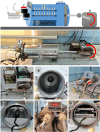Effect of conventional cigarette smoking and recent heated tobacco products on CAD/CAM restorative materials
- PMID: 38970080
- PMCID: PMC11227156
- DOI: 10.1186/s12903-024-04423-2
Effect of conventional cigarette smoking and recent heated tobacco products on CAD/CAM restorative materials
Abstract
Objective: To determine the effects of conventional cigarette smoking (CS) and recent heated tobacco products (HTPs) on the surface roughness and color stability of different indirect restorative materials.
Materials and methods: One hundred disc-shaped samples were constructed of three different restorative CAD/CAM materials: lithium disilicate glass-ceramic (IPS e.max CAD; Ivoclar Vivadent, Liechtenstein), zirconia (BruxZir® Zirconia, Glidewell, USA) and polyetheretherketone (BioHPP® bredent GmbH, Germany). Of the IPS e.max CAD and the Bruxzir samples, 20 samples were glazed, and 20 samples were polished, while the BioHPP samples were all polished according to the manufacturer's instructions. Fifty samples were subjected to conventional cigarette smoking (LM, Philip Morris International Inc., Egypt) (Groups: IPS e.max CAD_Glazed exposed to CS (LD_G_Cig), IPS e.max CAD_Polished exposed to CS (LD_P_Cig), Bruxzir_Glazed exposed to CS (Zr_G_Cig), Bruxzir _Polished exposed to CS (Zr_P_Cig) and BioHPP exposed to CS (PEEK_Cig) and fifty samples were exposed to heated tobacco product smoking (Heets, Russet selection, Philip Morris International Inc., Italy) (Groups: IPS e.max CAD_Glazed exposed to HTP (LD_G_HTP), IPS e.max CAD_Polished exposed to HTP (LD_P_HTP), Bruxzir_Glazed exposed to HTP (Zr_G_HTP), Bruxzir CAD_Polished exposed to HTP (Zr_P_HTP) and BioHPP exposed to HTP (PEEK_HTP).. Six hundred cigarettes/heets representing 30 days of medium smoking behavior (20 cigarettes/day) were used. Before and after exposure to smoke, the surface roughness of all the samples was measured using JITAI8101 surface roughness tester (Beijing Jitai Tech Detection Device Co., Ltd, China, and the color parameters were assessed using VITA Easyshade Advance 4.01 (VITA shade, VITA made, VITA). The data were analyzed using One-way ANOVA, paired sample t-test and independent sample t-test. The significance level was set at α < 0.05. The surface topography was evaluated by scanning electron microscopy (SEM) and analyzed using energy-dispersive X-ray (EDX) spectroscopy to determine changes in the surface chemical composition.
Results: Both types of smoking caused significant increases in the surface roughness of all the samples. There was a significant difference in color change between CS and HTP for all materials with different surface finish (P < 0.01) and zirconia had the greatest effect on color change (P < 0.001). In contrast, polyetheretherketone (PEEK) "BioHPP" had the least effect (P < 0.001).
Conclusion: Exposure to different types of smoking induce changes in the surface topography and color of different esthetic restorative materials. Compared with HTP, conventional cigarette smoke has a greater effect on the surface roughness and color stability of esthetic restorative materials. The glazed surfaces showed less change in surface topography than did the polished surfaces. Zirconia showed better color stability when compared to polyetheretherketone (PEEK).
Keywords: Cigarette smoking; Color stability; Heated tobacco products; Surface roughness.
© 2024. The Author(s).
Conflict of interest statement
The authors declare no competing interests.
Figures








References
-
- Della Bona A. Bonding to ceramics: scientific evidences for clinical dentistry: Scion Publishing Limited; 2009. ISBN: 8536700912, 9788536700915.
-
- Ho GW, Matinlinna JP. Insights on Ceramics as Dental Materials. Part I: Ceramic Material Types in Dentistry. Silicon. 2011;3(3):109–15. doi: 10.1007/s12633-011-9078-7. - DOI
MeSH terms
Substances
LinkOut - more resources
Full Text Sources
Research Materials
Miscellaneous

